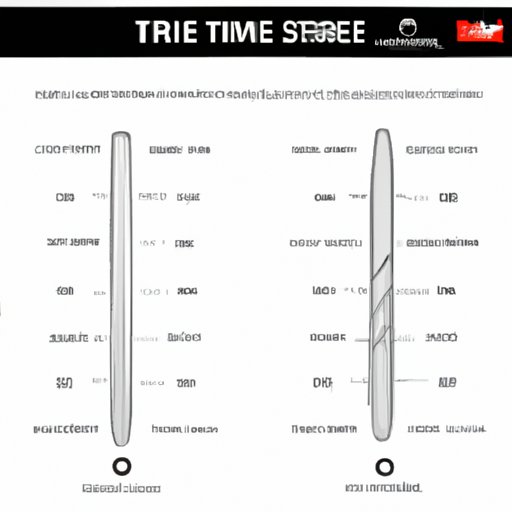I. Introduction
Understanding tire sizes can be a daunting task for many people. In addition to the numbers and letters on a tire’s sidewall often being hard to read, different types and sizes of tires also have different markings that can further confuse people. This article is designed to provide readers with a comprehensive guide on how to read tire sizes, including tips and tricks, using visuals to help illustrate key points and answering commonly asked questions.
II. Step-by-Step Guide: How to Read Tire Sizes
The tire size is the combination of numbers and letters on the sidewall of a tire that denotes its dimensions. The information can include tire width, aspect ratio, diameter, load index, and speed rating.
Tire Width: The tire width is the first number listed on the tire’s sidewall, written in millimeters. It measures the width of the tire from one sidewall to the other, not including any bulges or raised features. For example, if the tire width is listed as 235, it means that the tire is 235mm wide.
Aspect Ratio: After the tire width, you will find the aspect ratio. This figure can be found after a slash mark, and it tells you how tall the tire’s profile is. It is usually written as a percentage of the tire’s section width.
Diameter: The diameter is the last number listed on the tire’s side-wall. It is the measurement of the wheel’s inner diameter and is always given in inches.
Load Index: The load index refers to a tire’s ability to support its weight. Load indexes can range from 1-279, with each index corresponding to a weight-carry capacity.
Speed Rating: The speed rating is the last thing listed on a tire’s sidewall and represents the maximum speed at which the tire can safely operate. It is usually a single letter, with “V” being the most common speed rating used for passenger cars and light trucks, and “Z” being the highest rating for performance vehicles.
Tips and things to keep in mind:
- It is important to note that not all tire sizes are the same, even if they have the same numbers and letters on the sidewall. Different tire manufacturers may have slight variances in the measurements they use.
- Check your vehicle owner’s manual or the manufacturer’s information placard on the door jamb for the recommended tire size for your vehicle.
- Never replace one tire with a different-sized tire, as it can damage your vehicle’s drivetrain or cause handling issues.
III. Commonly Asked Questions about Tire Sizes
Q: Why do tire sizes vary?
A: Tire sizes vary based on a wide range of factors, including the weight and load capacity of a vehicle, the terrain it drives on, and manufacturer preference.
Q: How do I correctly measure tires?
A: The easiest way to get accurate tire measurements is by reading the sidewall of the existing tire. The tire width can be measured by using a tape measure across the tire tread from one sidewall to the other.
Q: What do the abbreviations on a tire’s sidewall mean?
A: The abbreviations on a tire’s sidewall denote important information such as the tire’s speed rating, load index, traction rating, temperature rating, and construction type.
IV. Interactive Tire Size Tool
To help readers determine their tire size quickly and easily, we have developed an interactive tool. Use this tool by answering a series of questions to find out your tire size. The tool will guide you through each element of the tire size and help you understand how to read it. Don’t have a tire to look at? No problem! We will provide explanations and examples for each tire component.
Tire Width: The tire width is the distance between the widest points of the tire measured in millimeters. This would be the first figure mentioned.
Aspect Ratio: This figure is the height of the tire’s profile as a percentage of its width.
Diameter: The diameter is the size of the wheel the tire fits and is expressed in inches.
Load Index: This parameter denotes how much load the tire can bear safely, and it is usually mentioned next to the tire width number.
Speed Rating: This letter denotes the top speed of the tire and is usually towards the end of a tire’s size specifications.
V. Quick Reference Chart
For a quick and easy-to-understand visual, we have created a tire size chart. The chart uses colors and illustrations to clearly indicate each element of the tire size and includes grids for common tire sizes to help readers quickly understand the meaning of each dimension. Make sure to keep this handy for your next tire purchase!
VI. Video Tutorial
For those who prefer visual and animated formats, we have also created a video tutorial. The video covers how to read various types of tire sizes, using visuals and animations to help viewers better understand tire size and its elements. Throughout the video, we provide tips and things to keep in mind when reading tire sizes.
VII. Conclusion
Reading tire sizes can be challenging, but with this guide, we hope you can quickly decipher what the numbers and letters mean. Knowing how to read tire size is crucial when replacing and buying tires, as you want to make sure the new tire is suitable for your car. With the help of the step-by-step guide, frequently asked questions, interactive tire size tool, quick reference chart, and video tutorial, you now have all the resources you need to read tire sizes confidently.
